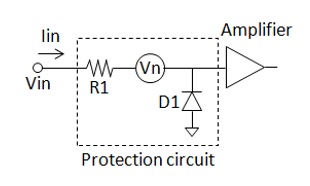Posted 2020/5/20
There are various types of amplifiers for measuring small AC signals, but it is quite difficult
to measure AC signals superimposed on large DC signals.
This document provides product information for preamplifiers suitable for such
measurements.
A noise signal is also a type of AC signal, so this content can be applied to low noise
measurements as well.
Contents
Measurement of a small AC signal superimposed on a DC signal requires a dynamic range that includes the DC signal. For example, when measuring a small AC signal of 1 mV AC superimposed on a DC signal of 10 V, the measurement voltage range of the instrument should be set to 10 V or above. When measuring an AC signal of 1 mV in the measurement range of 10 V, a dynamic range of 80 dB (resolution 14 bits) or more is required. Larger DC signals make measuring AC signals more difficult because of the need for instruments with greater dynamic range. The dynamic range of general-purpose measuring instruments such as oscilloscopes has a resolution of about 8 bits, which corresponds to a dynamic range of 48 dB.
For such measurements, it is necessary to remove the DC signal by AC coupling. The measurement range can be selected based on the level of the small AC signal. The dynamic range required for measurement of an AC signal at 1mV is shown in Table 1. If the measurement range can be set to 100 mV, the dynamic range required to measure an AC signal of 1 mV is 40 dB. The removal of the DC signal reduces the required dynamic range, which makes it possible to measure small AC signals.
Table 1. Dynamic range required for the measurement of an AC voltage at 1 mV
| Measurement Range Setting (of measuring instrument) |
Required Dynamic Range (Resolution) |
|---|---|
| 10 V | 80 dB (14bit or higher) |
| 1 V | 60 dB (10bit or higher) |
| 100 mV | 40 dB (7bit or higher) |
Measurement of small AC signals is affected by the output noise of the instrument. For example, the noise level of a general-purpose digital oscilloscope is a few mV, and it is not possible to measure small AC signals in the order of microvolts. The low noise preamplifier can be used to measure small AC signals. However, most types of low noise preamplifiers have a limited input signal range and damage could occur to the amplifier when a large DC signal is input. Even with AC coupled low noise amplifiers, there is an upper limit on the DC signal removable.
A resistor and diode circuit are used as a protection to prevent damage to the amplifier from large voltage inputs. (Figure 1.) However, increasing the resistance value for protection increases the thermal noise of the resistance and affects the output of the amplifier. Increasing the input protection level may increase the output noise.
For example, when the input voltage Vin is 40V in the circuit of Figure 1, the protection resistor R1 needs to be 4kΩ or above to suppress the current Iin. The thermal noise of a 4 kΩ resistor is 8.1 nV/√Hz at room temperature. Therefore, this protection circuit cannot measure very small signals.
Figure 1. Example of an Input Protection Circuit
